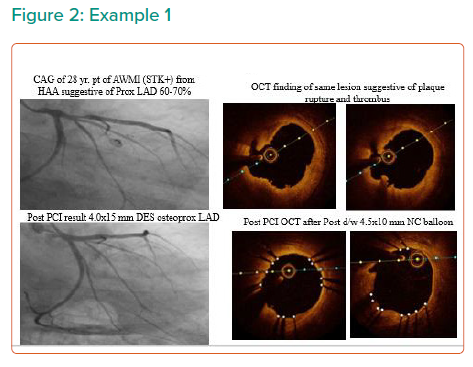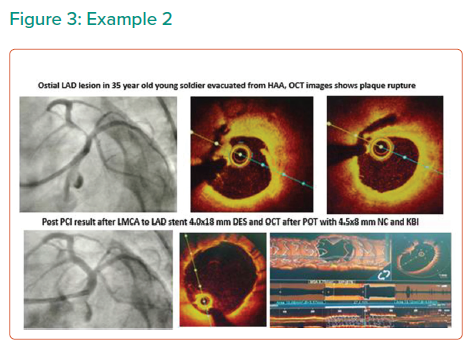Aim: To present our experience of study of clinical profile and optical coherence tomography (OCT) guided management of young patients (<45 years) presenting with acute coronary syndrome (ACS) during the study period.
Methods: This is a single centre observational study. A total of 119 cases with age <45 years of acute coronary syndrome, who underwent cardiac evaluation with coronary angiography and proceed at our hospital during study period October 2019 to September 2020 were included.
Findings and results: All patients were men. Age ranged from 23 years to 45 years. All the patients survived (mortality nil).
The most common presentation was unstable angina in 57 (47.9%), ST-elevation MI in 46 (38.6%), with further subdivision into 28 (60.8%) anterior wall MI, 12 (26.1%) as inferior wall MI and six (13.0%) patients as true posterior wall MI. The remaining 14 (11.7%) patients had non-ST-elevation MI.
The most common coronary angiogram finding was patent coronaries with slow flow in 64 (53.8%) patients, while obstructive coronary artery disease (CAD) was seen in 55 (46.2%) patients with distribution of single vessel disease (SVD) in 37 (67.3%), double vessel disease (DVD) in 12 (21.8%) and triple vessel disease (TVD) in the remaining six (10.9%) patients.
Left anterior descending artery (LAD) was the most common vessel involved in 33 (60%), followed by right coronary artery (RCA) in 14 (25.5%) and left circumflex artery (LCx) in eight (14.5%) patients
Of the 55 patients diagnosed with obstructive CAD, 31 patients (56.4%) had large intracoronary thrombus burden in the culprit vessel. Of these, 14 patients (45.1%) overall, and 85.7% in particular belonging to high altitude areas (HAA), underwent deferred stenting intracoronary lysis with either tPA 10 mg or TNK 5–8 mg (1/5 dose depending on body weight). This was followed by GP IIb IIIa infusion for 24 hours and then a 7-day course of low molecular weight heparin (LMWH) at a dosage of 1g/kg twice daily. Thereafter all these patients underwent check coronary angiogram and OCT study. After following this novel approach, only two (14.3%) required stenting as OCT revealed plaque rupture. Thus in 85.7% of this cohort stenting could be avoided.
Conclusion: Young ACS is a substrate that needs to be studied for the presence of traditional as well as specific risk factors. In our study population cohort, 59.3% patients were posted in HAA and approximately 40% of these were smokers too. With the use of deferred stenting and OCT guidance, we managed to avoid stenting in approximately 85.7% of patients in this substrate with high thrombus burden on initial angiogram.













